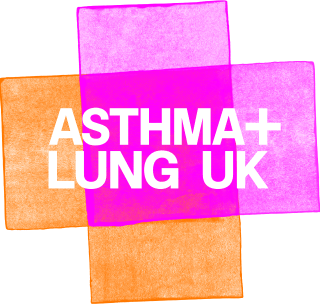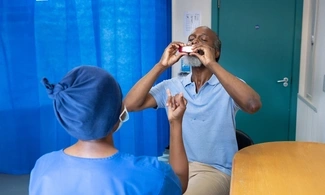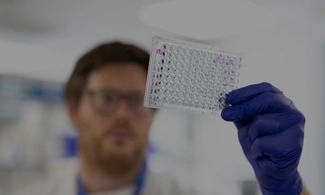Treating bronchiectasis
This page will help you to understand the management of bronchiectasis, and what your role is in supporting a patient with bronchiectasis in primary care.
This is not a substitute for completing an appropriate respiratory assessment module. For advice and support on choosing the right course for you, please see our training and development page.
The aim of bronchiectasis management is to:
- avoid further lung damage
- prevent exacerbations and
- manage symptoms
Check that your patient understands their diagnosis
Send them a link to our bronchiectasis health advice pages and our Living with Bronchiectasis leaflet
Signpost them to our helpline, where they can talk through their diagnosis in more detail with one of our specialist nurses.
They can also join one of our support groups, so that they can understand more about their condition and meet other people living with a lung condition.
Manage any underlying conditions
Managing underlying conditions in bronchiectasis is essential because they often contribute to disease progression and can worsen symptoms or increase exacerbation risk if left unaddressed.
Conditions such as rhinosinusitis, asthma and COPD should be treated according to national guidelines.
Refer for respiratory physiotherapy
Airway clearance is the cornerstone of managing bronchiectasis and is essential to allow patients to cough up sputum from the airways so that it does not cause infections.
Refer your patient to a respiratory physiotherapist who will create a physiotherapy regime for them, often using their CT scan to help target the areas of the lung that are affected.
This regime is usually the active cycle of breathing (ACB).
ACB should be undertaken twice daily for up to 30 minutes for best effect, although this will differ from patient to patient. Airway clearance will need to be done more frequently during an exacerbation.
Your patient may also be taught gravity assisted drainage. This technique uses gravity to assist in the drainage of sputum, and involves lying with the head lower than the chest in a tipped position.
Be aware that some people find tipping uncomfortable especially if they have COPD as it makes them breathless, and it can make conditions like reflux worse.
Patients should be reviewed by their physiotherapist after 3 months
If your patient is finding ACB and/or postural draining ineffective, finding it hard to get in a consistent routine, or has had 3 or more exacerbations the physiotherapist may offer them an oscillating positive pressure device such as the flutter, aerobika, or the acapella.
These devices help clear the sputum by pushing it though the airways so that it can be coughed up more easily. They should be replaced yearly.
Discuss mucolytics
If your patient’s sputum is especially thick and difficult to cough up, it's important that they stay hydrated, as this will thin out the sputum.
Encourage your patient to increase their fluid intake if necessary. Some patients benefit from putting a reminder on their phones or having a water bottle that shows how much water they have drunk in a day.
Mucolytics such as Carbocisteine and Acetylcysteine can be given to patients with excessive sputum production. They work by breaking down the mucus structure, making it thinner and easier for your patient to cough up. In some patients mucolytics can also reduce the volume of sputum produced.
It’s not always easy to predict whether your patient will respond to mucolytic therapy so they should trial it for 6 months. Find out more about prescribing mucolytics.
If mucolytics do not help, your patient’s specialist team patient can prescribe nebulised isotonic or hypertonic saline to use prior to their chest clearance to help break up the secretions.
Offer vaccination
Patients with bronchiectasis should be vaccinated for
If your patient has low levels of pneumococcal antibodies, their specialist may ask you to revaccinate them.
Refer to pulmonary rehab
Patients who have completed a Pulmonary Rehabilitation (PR) course experience less breathlessness and less fatigue. They will have greater exercise tolerance, better quality of life and have fewer exacerbations.
Lack of physical exercise and deconditioning are associated with a worse prognosis for patients with bronchiectasis.
You should refer any patient with bronchiectasis who has an mMRC score of more than 1.
Pulmonary rehabilitation courses include:
- Structured education
- Lifestyle support
- Personalised exercises so that people with bronchiectasis can be confident to live well with their condition.
Watch this video for more information. Patient uptake of PR is low so it is important that you are able to inspire your patients to attend. Read this quick guide to find out how to explain to your patients what PR is and how it will help them.
Some areas have long waits for PR. To bridge this gap, signpost your patient to the A+LUK Keep Active Programme which has been created by specialist respiratory physiotherapists for anyone living with a lung condition and includes three levels for your patient to choose from.
The videos are supported by the My Keep Active Handbook.
Consider inhaled therapies
Patients with bronchiectasis should not be given inhaled corticosteroids unless they also have a diagnosis of asthma or COPD with high blood eosinophils.
They should not be offered short acting bronchodilators (SABAs) unless they have asthma or COPD.
If your patient is struggling with breathlessness, you can trial them on a long acting bronchodilator or a long acting muscarinic agonist either singly or as a combined inhaler.
It’s essential that patients are shown how to use their inhalers and are prescribed a device that is suitable for them. Click here for help on choosing the right inhaler device for your patient. Metered dose inhalers (MDIs) should always be used with a spacer.
Review after 4-8 weeks, check inhaler technique and adherence and discontinue if it is not helping.
Refer for prophylactic antibiotic therapy
- If your patient is at high risk of exacerbations i.e
- you feel that they are deteriorating
- they have ≥2 exacerbations a year, one severe episode, or one exacerbation plus severe daily symptoms
- have symptoms that are not improving with repeated courses of oral antibiotics, or
- have bacteria in their sputum that are resistant to the available oral antibiotics
- If they have new onset pseudomonas aeruginosa in their sputum
then you should refer them to a specialist team for consideration of long term antibiotic therapy. These may be oral, inhaled or nebulised, depending on the results of their sputum culture.
The specialist team will start and monitor long term antibiotics, changing them if and when necessary.
In patients with severe bronchiectasis, intravenous antibiotics may be recommended by the specialist team. These can be given at home, and some patients can self-administer once taught.
Support with cough management
The chronic, productive cough in bronchiectasis can be exhausting and distressing, affecting sleep, daily activities, and social confidence. Encourage your patient to talk about how their cough affects their everyday life. The Let’s Talk About Cough website has a wealth of resources for patients to learn strategies to manage their cough.
Cough incontinence is often under reported in bronchiectasis and can be highly distressing for patients. Your patient may not raise this with you so you should ensure that you ask if this is a problem for them. You can refer them to your local continence service or to the Squeezy app.
Create a self management plan
A personalised self-management plan is essential for patients with bronchiectasis and should offer clear guidance on daily treatments, airway clearance techniques, and specific actions to take during exacerbations.
The plan should be jointly created and agreed upon by your patient and their specialist team but if this has not happened or they are not under a specialist team, you will need to develop one in primary care, using the A+LUK Bronchiectasis self management plan. It’s important to make sure your patient understands what steps they should take if their start to deteriorate.
The plan should be uploaded to their notes and a copy either printed out or sent to them digitally. Review and update it regularly, for example when medication is changed or following an exacerbation.
Some patients may be able to keep a 'rescue pack' antibiotics at home as part of their self-management plan to enable them to promptly treat exacerbations.
This is only appropriate if your patient can recognise the signs of symptom worsening and can self-administer antibiotics safely. If your patient is already taking prophylactic antibiotics, make sure that they know to stop these whilst they are taking their rescue pack.
Ensure that your patient has a supply of sputum pots at home and knows when to bring a sample in.







